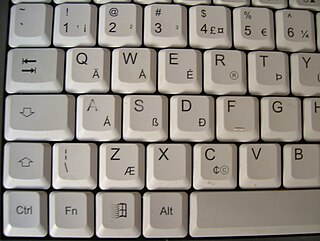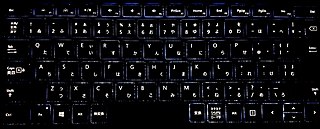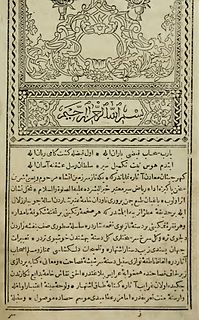
The Arabic alphabet or Arabic abjad is the Arabic script as it is codified for writing Arabic. It is written from right to left in a cursive style and includes 28 letters. Most letters have contextual letterforms.

QWERTY is a keyboard design for Latin-script alphabets. The name comes from the order of the first six keys on the top left letter row of the keyboard. The QWERTY design is based on a layout created for the Sholes and Glidden typewriter and sold to E. Remington and Sons in 1873. It became popular with the success of the Remington No. 2 of 1878, and remains in widespread use.
In computing, a modifier key is a special key on a computer keyboard that temporarily modifies the normal action of another key when pressed together. By themselves, modifier keys usually do nothing; that is, pressing any of the ⇧ Shift, Alt, or Ctrl keys alone does not (generally) trigger any action from the computer.

The QWERTZ or QWERTZU keyboard is a typewriter and keyboard layout widely used in Central Europe. The name comes from the first six letters at the top left of the keyboard:.

AZERTY is a specific layout for the characters of the Latin alphabet on typewriter keys and computer keyboards. The layout takes its name from the first six letters to appear on the first row of alphabetical keys; that is,. Similar to the German QWERTZ layout, it is modelled on the English QWERTY layout. It is used by most French speakers based in Europe, although France and Belgium each have their own national variations on the layout. Luxembourg and Switzerland use the Swiss QWERTZ keyboard. Most of the residents of Quebec, the mainly French-speaking province of Canada, use a QWERTY keyboard that has been adapted to the French language such as the Multilingual Standard keyboard CAN/CSA Z243.200-92 which is stipulated by the government of Quebec and the Government of Canada.
A dead key is a special kind of a modifier key on a mechanical typewriter, or computer keyboard, that is typically used to attach a specific diacritic to a base letter. The dead key does not generate a (complete) character by itself, but modifies the character generated by the key struck immediately after. Thus, a dedicated key is not needed for each possible combination of a diacritic and a letter, but rather only one dead key for each diacritic is needed, in addition to the normal base letter keys.

The shift key is a modifier key on a keyboard, used to type capital letters and other alternate "upper" characters. There are typically two shift keys, on the left and right sides of the row below the home row. The shift key's name originated from the typewriter, where one had to press and hold the button to shift up the case stamp to change to capital letters;
the shift key was first used in the Remington No. 2 Type-Writer of 1878; the No. 1 model was capital-only.

Caps Lock is a button on a computer keyboard that causes all letters of Latin-based scripts to be generated in capitals. It is a toggle key: each press reverses its action. Some keyboards also implement a light, so as to give visual feedback about whether it is on or off. Exactly what Caps Lock does depends on the keyboard hardware, the operating system, the device driver, and the keyboard layout. Usually, the effect is limited to letter keys; letters of Latin-based scripts are capitalised, while letters of other scripts and non-letter characters are generated normally.

AltGr is a modifier key found on some computer keyboards and is primarily used to type characters that are unusual for the locale of the keyboard layout, such as currency symbols and accented letters. On a typical, IBM-compatible PC keyboard, the AltGr key, when present, takes the place of the right-hand Alt key. In macOS, the Option key has functions similar to the AltGr key.
Taw, tav, or taf is the twenty-second and last letter of the Semitic abjads, including Phoenician Tāw , Hebrew Tav ת, Aramaic Taw , Syriac Taw ܬ, and Arabic ت Tāʼ. In Arabic, it is also gives rise to the derived letter ث Ṯāʼ. Its original sound value is.

Japanese input methods are the methods used to input Japanese characters on a computer.

The Ottoman Turkish alphabet is a version of the Perso-Arabic alphabet used to write Ottoman Turkish until 1928, when it was replaced by the Latin-based modern Turkish alphabet.

A Hebrew keyboard comes in two different keyboard layouts. Most Hebrew keyboards are bilingual, as Latin characters are necessary for URLs and Email addresses. Trilingual keyboard options also exist, with the third script being Arabic or Russian, due to the sizable Arabic- and Russian-speaking populations in Israel.
ISO/IEC 9995 Information technology — Keyboard layouts for text and office systems is an ISO standard series defining layout principles for computer keyboards. It does not define specific layouts but provides the base for national and industry standards which define such layouts.
FITALY is a keyboard layout specifically optimized for stylus or touch-based input. The design places the most common letters closest to the centre to minimize distance travelled while entering a word. The name, FITALY, is derived from the letters occupying the second row in the layout

In computing, a computer keyboard is a typewriter-style device which uses an arrangement of buttons or keys to act as mechanical levers or electronic switches. Following the decline of punch cards and paper tape, interaction via teleprinter-style keyboards became the main input method for computers.

The Dvorak Simplified Keyboard ( d -VOR-ak) is a keyboard layout patented during 1936 by August Dvorak and his brother-in-law, William Dealey. Several modifications have since been designed by the team directed by Dvorak or by ANSI. These variations have been collectively or individually termed the Simplified Keyboard or American Simplified Keyboard, but they all have come to be known commonly as the Dvorak keyboard or Dvorak layout;
A keyboard layout is any specific mechanical, visual, or functional arrangement of the keys, legends, or key-meaning associations (respectively) of a computer, typewriter, or other typographic keyboard.
Mechanical layout is the placements and keys of a keyboard. Visual layout is the arrangement of the legends that appear on the keys of a keyboard. Functional layout is the arrangement of the key-meaning associations, determined in software, of all the keys of a keyboard.
The German keyboard layout is a QWERTZ keyboard layout commonly used in Austria and Germany. It is based on one defined in a former edition of the German standard DIN 2137-2. The current edition DIN 2137-1:2012-06 standardizes it as the first (basic) one of three layouts, calling it "T1".

MessagEase is an input method and virtual keyboard for touchscreen devices. It relies on a new entry system designed by Saied B. Nesbat, formatted as a 3x3 matrix keypad where users may press or swipe up, down, left, right, or diagonally to access all keys and symbols. It is a keyboard that was designed for devices like cell phones, mimicking the early cell phones' limited number of 12 keys.













